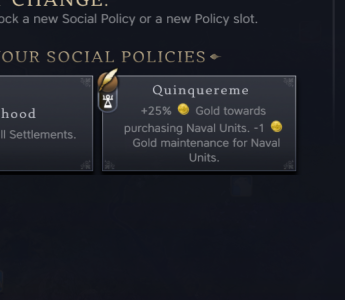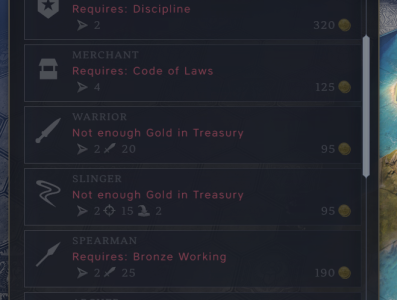Noble Zarkon
Elite Quattromaster - Immortal (BTS)
Super Moderator
Hall of Fame Staff
GOTM Staff
Supporter
From humble colony to economic hegemony, Carthage rose from the shores of North Africa to dominate the Mediterranean Sea. Its sleek ships ferried goods and riches all over the known world, while at home, the city of Carthage was famed for its master craftsmen and deep agricultural knowledge. Competition with first Greece, then Rome, honed renowned generals and a powerful navy. But war was Carthage’s undoing, and the city was destroyed in 146 BCE.
Unique Ability
Phoenician Heritage: Can only have one City. Towns cannot use Convert to City. When you create a Merchant or Colonist Unit, gain a copy of that Unit.Attributes
- Militaristic
- Economic
Civic Trees
Shipsheds- Tier 1: Increased Movement for Naval Units. Unlocks the Cothon Unique Building and Byrsa Wonder.
- Tier 2: Increased Range for Naval Units. Unlocks the 'Quinquereme' Tradition.
- Tradition - Quinquereme: Increased Gold towards purchasing Naval Units. Decreased Gold maintenance for Naval Units.
Wisdom of Tanit
- Tier 1: Increased Sea Trade Route Range. Increased Gold in the Capital for every Trade Route from the Capital. Unlocks the Dockyard Unique Building.
- Tier 2: Increased Resource Cap in the Capital. Unlocks the 'Gaulos' Tradition.
- Tradition - Gaulos: Increased Gold towards purchasing Buildings on Coast or Navigable Rivers.
Sicilian Wars
- Tier 1: Increased Settlement Cap. Unlocks the 'Suffetes' Tradition.
- Tradition - Suffetes: Increased Gold from Mining Towns. Increased Food from Fishing or Farming Towns.
- Tier 2: Increased Movement and Sight for the Numidian Cavalry Unique Cavalry Unit.
Unique Infrastructure
Punic Port: Unique Quarter. Increased Resource Capacity in this Settlement. Can be built in Towns.Cothon: Unique Building. Production Base. Production adjacency with Coast and Navigable Rivers. Must be built on a Coast tile.
Dockyard: Unique Building. Gold Base. Food adjacency with Resources and Districts. Must be built on a Coast tile.
Unique Civilian Unit
Colonist: Replaces Settler. Increased Embarked Movement. Increased Population if settled adjacent to a Resource.Unique Military Unit
Numidian Cavalry: Unique Cavalry Unit. Can only be purchased and are more expensive than other Cavalry Units. Increased Combat Strength for each Unique City Resource assigned to your Capital.Associated Wonder
Byrsa: Gold Base. Trade Routes from this Settlement cannot be plundered. All tiles in this City that are adjacent to Coast and eligible for Walls receive a Wall. Must be placed adjacent to a Coast tile.Starting Biases
- Coast
Last edited by a moderator:



 I do love that my idea of a unique Settler who embarks faster made it in, though.
I do love that my idea of a unique Settler who embarks faster made it in, though.